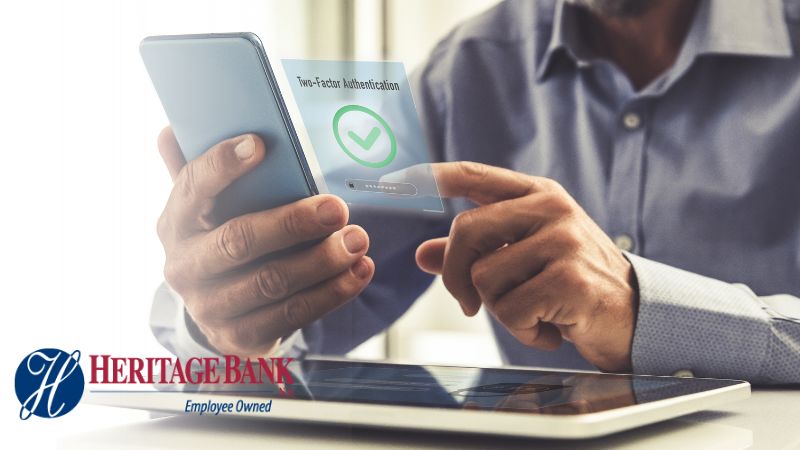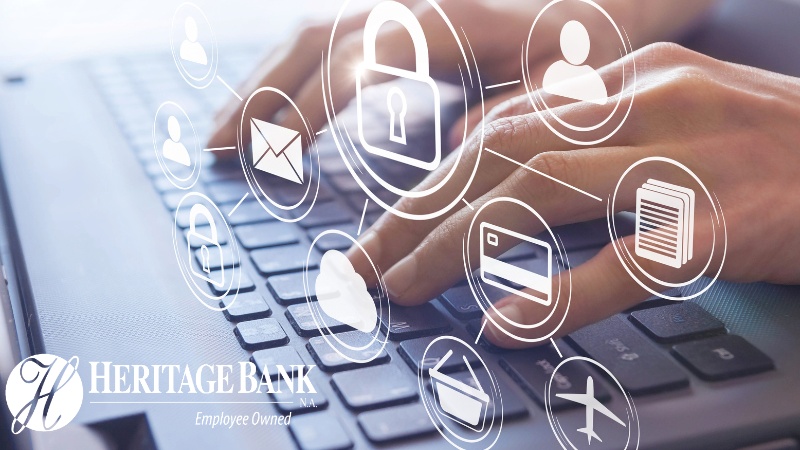Cybercriminals compromise millions of accounts every year, often through weak or stolen passwords. Your banking information, personal data, and financial security depend on the strength of your password protection. At Heritage Bank NA, we recognize that maintaining the security of your accounts is crucial to your financial well-being.
This comprehensive guide covers proven strategies to protect your accounts from unauthorized access. You’ll learn how to create strong passwords, implement multi-factor authentication, and recognize common threats. By following these practical steps, you can significantly reduce your risk of becoming a victim of cybercrime and enjoy greater peace of mind when banking online.
Understanding Password Complexity
Strong password creation forms the foundation of account security. Many people underestimate the importance of password complexity; however, understanding these principles can help prevent costly security breaches.
Essential Length Requirements
Your passwords should be at least 12 to 16 characters long. Longer passwords exponentially increase the time required for cybercriminals to crack them through automated attacks. Each additional character dramatically improves your security.
Character Variety Matters
Effective passwords combine multiple character types:
- Upper and lowercase letters (A-Z, a-z)
- Numbers (0-9)
- Special characters (!@#$%^&*)
This variety makes your password significantly harder to guess or crack using common attack methods.
Avoiding Common Mistakes
Never use easily guessable information in your passwords. Avoid:
- Personal information like birthdays or anniversaries
- Reusing the same password on multiple sites
- Common words found in dictionaries
- Simple patterns like “123456” or “password”
- Your name or your family members’ names
Cybercriminals often use personal information from social media profiles to guess passwords, making these choices particularly vulnerable.
The Power of Passphrases
Passphrases offer an excellent alternative to traditional complex passwords. They’re longer, easier to remember, and highly secure when appropriately created.
Creating Memorable Passphrases
Use a combination of random words to create your passphrase. For example: “coffee-mountain-bicycle-sunset” creates a strong, memorable password. The randomness makes it difficult to guess, yet it remains easy for you to remember.
You can also use meaningful sentences with modifications. Take a phrase like “I love banking at Heritage Bank” and modify it to “1L0ve8anking@Heritage8ank!” by replacing letters with numbers and symbols.
Adding Complexity to Passphrases
Enhance your passphrases by:
- Including spaces between words
- Adding punctuation marks
- Capitalizing random letters (not just the first letter)
- Substituting some letters with numbers or symbols
These modifications maintain memorability while significantly increasing security strength.
Multi-Factor Authentication (MFA): Your Security Shield
Multi-factor authentication provides an additional layer of security beyond your password. This system requires you to verify your identity using two or more methods before accessing your account.
How MFA Works
MFA typically combines:
- Something you know (your password)
- Something you have (your phone or security token)
- Something you are (fingerprint or facial recognition)
Even if cybercriminals steal your password, they cannot access your account without the additional verification factors.
Implementing MFA on Your Accounts
Enable MFA on all accounts that offer this feature, particularly:
- Banking and financial accounts
- Email accounts
- Social media platforms
- Work-related accounts
- Shopping and e-commerce sites
Most major services now offer MFA options, including text message codes, authenticator apps, or hardware tokens.

Password Management Tools: Simplifying Security
Password managers solve the challenge of remembering multiple complex passwords while maintaining high security standards.
Benefits of Password Managers
These tools offer several advantages:
- Generate strong, unique passwords automatically
- Store passwords securely using encryption
- Fill in login information automatically
- Sync across all your devices
- Alert you to compromised passwords
Choosing the Right Password Manager
Look for password managers that offer:
- Strong encryption standards
- Two-factor authentication for the manager itself
- Regular security audits and updates
- Compatibility across your devices
- Secure password sharing features
Popular options include established services that have proven track records in security and reliability.
Best Practices for Password Managers
- Use a strong master password for your password manager
- Enable two-factor authentication on your password manager account
- Regularly update your password manager software
- Backup your password vault securely
- Review and remove outdated account information
Recognizing and Avoiding Phishing Scams
Phishing scams trick users into revealing passwords and personal information through deceptive emails, websites, or messages.
Common Phishing Tactics
Be alert for these warning signs:
- Urgent messages claiming your account will be closed
- Requests for password verification via email
- Links that don’t match the claimed destination
- Poor grammar or spelling in official communications
- Requests for sensitive information through unsecured channels
Protecting Yourself from Phishing
Always verify requests for personal information by:
- Contacting the bank or organization directly through official channels
- Typing website addresses manually instead of clicking links
- Checking email addresses carefully for subtle misspellings
- Looking for secure website indicators (https://) before entering information
Never provide passwords, Social Security numbers, or banking information through email or text messages. Learn more about phishing scams here.
Reporting Suspicious Activity
If you encounter potential phishing attempts:
- Forward suspicious emails to your bank’s fraud department
- Report phishing websites to anti-phishing organizations
- Change your passwords immediately if you suspect compromise
- Monitor your accounts closely for unauthorized activity
Additional Security Measures
Beyond password security, implement these protective measures:
Device Security
Protect the devices you use for banking:
- Use strong passcodes or biometric locks
- Lock your computer when stepping away
- Keep software and operating systems updated
- Install reputable antivirus software
Regular Security Monitoring
Stay proactive about your account security:
- Check accounts regularly for unauthorized transactions
- Review credit reports annually
- Use services like “Have I Been Pwned” to check for data breaches
- Sign up for account alerts and notifications
Data Backup and Recovery
Maintain backups of important information:
- Regularly back up your password manager data
- Keep copies of important documents in secure locations
- Have a recovery plan if your primary devices are compromised
Protecting Your Financial Future
Strong password security is essential for protecting your financial accounts and personal information. By implementing these best practices — using complex passwords, enabling multi-factor authentication, and staying vigilant against phishing scams — you create multiple layers of protection against cyber threats.
At Heritage Bank NA, your security is our priority. We continuously invest in advanced security measures and encourage our customers to take these proactive steps. Remember to review and update your passwords regularly, especially after any security incidents or data breaches have occurred.
Start strengthening your password security today. Choose one account to update with a strong, unique password, then gradually work through all your accounts. Your future self will thank you for taking these important protective measures now.
Helping People Succeed Financially. We see every customer as an individual and treat our customers’ businesses as our own. Our dedicated, experienced staff is there for our customers on every step of their journey.






